PUBH620: Practice Reflection - Biostatistics and Public Health Policy
VerifiedAdded on 2023/06/11
|6
|1348
|156
Journal and Reflective Writing
AI Summary
This practice reflection explores the impact of a biostatistics course on the student's future practice in public health policy, planning, and management. Key concepts such as correlation, regression, risk assessment, analysis of variance, and meta-analysis are discussed in relation to their application in determining disease causes, establishing causal relationships, ensuring data accuracy, and improving health service delivery. The reflection emphasizes the importance of research translation, systematic reviews, and bias elimination in developing effective health policies. The student highlights enhanced skills in research design, sampling, data analysis, and critical appraisal of evidence, expressing confidence in their ability to address epidemic health issues and work in various fields requiring biostatistical knowledge. The document is available on Desklib, a platform offering study tools and solved assignments for students.
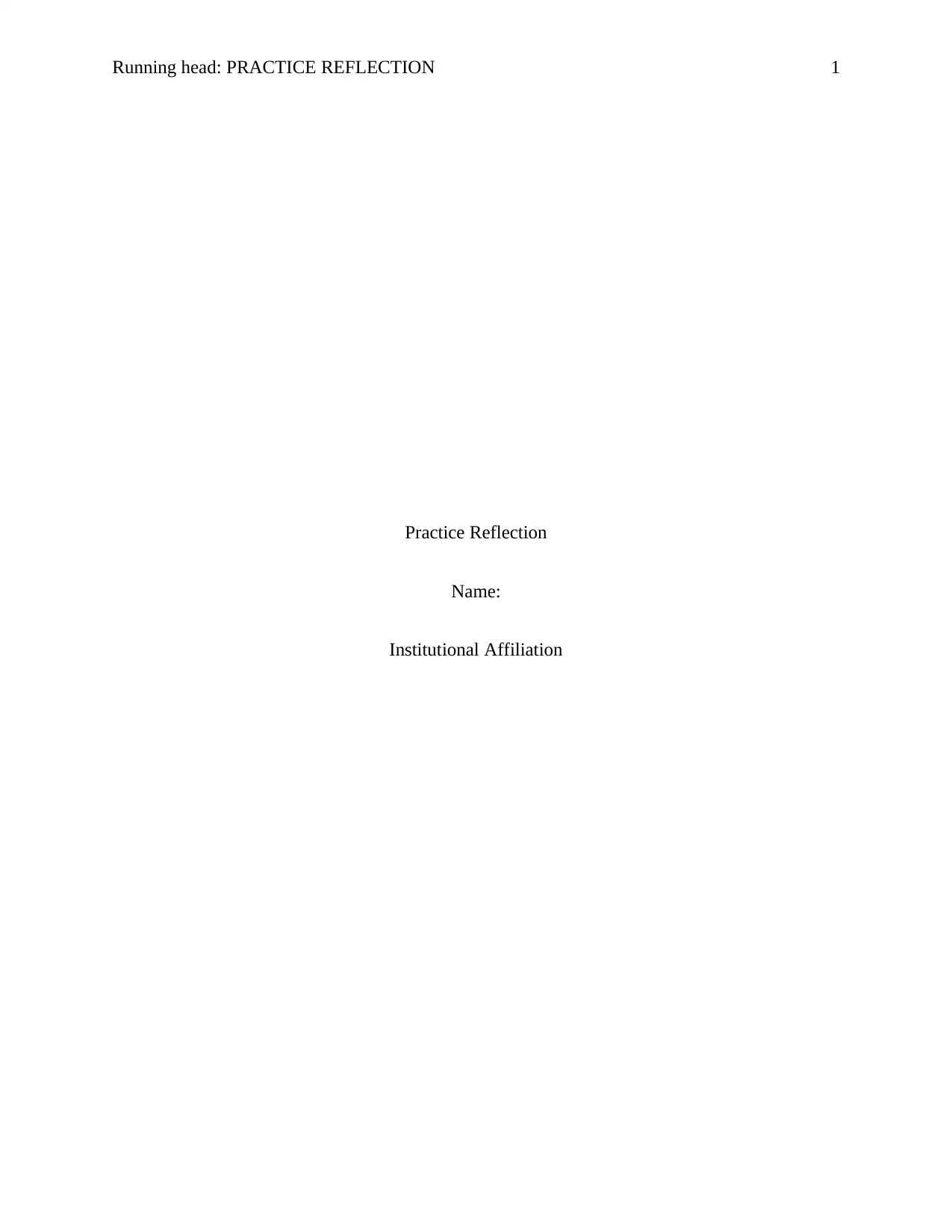
Running head: PRACTICE REFLECTION 1
Practice Reflection
Name:
Institutional Affiliation
Practice Reflection
Name:
Institutional Affiliation
Paraphrase This Document
Need a fresh take? Get an instant paraphrase of this document with our AI Paraphraser
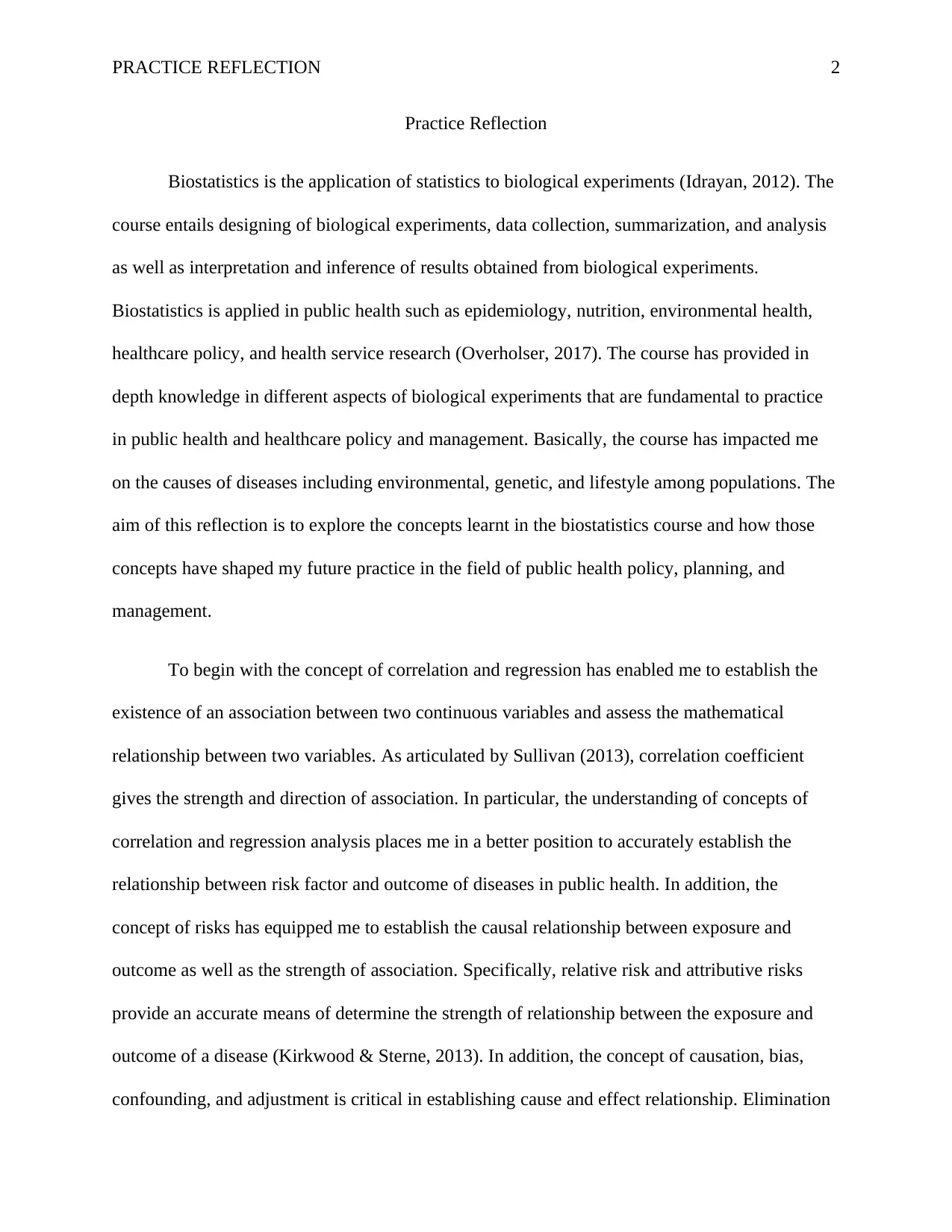
PRACTICE REFLECTION 2
Practice Reflection
Biostatistics is the application of statistics to biological experiments (Idrayan, 2012). The
course entails designing of biological experiments, data collection, summarization, and analysis
as well as interpretation and inference of results obtained from biological experiments.
Biostatistics is applied in public health such as epidemiology, nutrition, environmental health,
healthcare policy, and health service research (Overholser, 2017). The course has provided in
depth knowledge in different aspects of biological experiments that are fundamental to practice
in public health and healthcare policy and management. Basically, the course has impacted me
on the causes of diseases including environmental, genetic, and lifestyle among populations. The
aim of this reflection is to explore the concepts learnt in the biostatistics course and how those
concepts have shaped my future practice in the field of public health policy, planning, and
management.
To begin with the concept of correlation and regression has enabled me to establish the
existence of an association between two continuous variables and assess the mathematical
relationship between two variables. As articulated by Sullivan (2013), correlation coefficient
gives the strength and direction of association. In particular, the understanding of concepts of
correlation and regression analysis places me in a better position to accurately establish the
relationship between risk factor and outcome of diseases in public health. In addition, the
concept of risks has equipped me to establish the causal relationship between exposure and
outcome as well as the strength of association. Specifically, relative risk and attributive risks
provide an accurate means of determine the strength of relationship between the exposure and
outcome of a disease (Kirkwood & Sterne, 2013). In addition, the concept of causation, bias,
confounding, and adjustment is critical in establishing cause and effect relationship. Elimination
Practice Reflection
Biostatistics is the application of statistics to biological experiments (Idrayan, 2012). The
course entails designing of biological experiments, data collection, summarization, and analysis
as well as interpretation and inference of results obtained from biological experiments.
Biostatistics is applied in public health such as epidemiology, nutrition, environmental health,
healthcare policy, and health service research (Overholser, 2017). The course has provided in
depth knowledge in different aspects of biological experiments that are fundamental to practice
in public health and healthcare policy and management. Basically, the course has impacted me
on the causes of diseases including environmental, genetic, and lifestyle among populations. The
aim of this reflection is to explore the concepts learnt in the biostatistics course and how those
concepts have shaped my future practice in the field of public health policy, planning, and
management.
To begin with the concept of correlation and regression has enabled me to establish the
existence of an association between two continuous variables and assess the mathematical
relationship between two variables. As articulated by Sullivan (2013), correlation coefficient
gives the strength and direction of association. In particular, the understanding of concepts of
correlation and regression analysis places me in a better position to accurately establish the
relationship between risk factor and outcome of diseases in public health. In addition, the
concept of risks has equipped me to establish the causal relationship between exposure and
outcome as well as the strength of association. Specifically, relative risk and attributive risks
provide an accurate means of determine the strength of relationship between the exposure and
outcome of a disease (Kirkwood & Sterne, 2013). In addition, the concept of causation, bias,
confounding, and adjustment is critical in establishing cause and effect relationship. Elimination
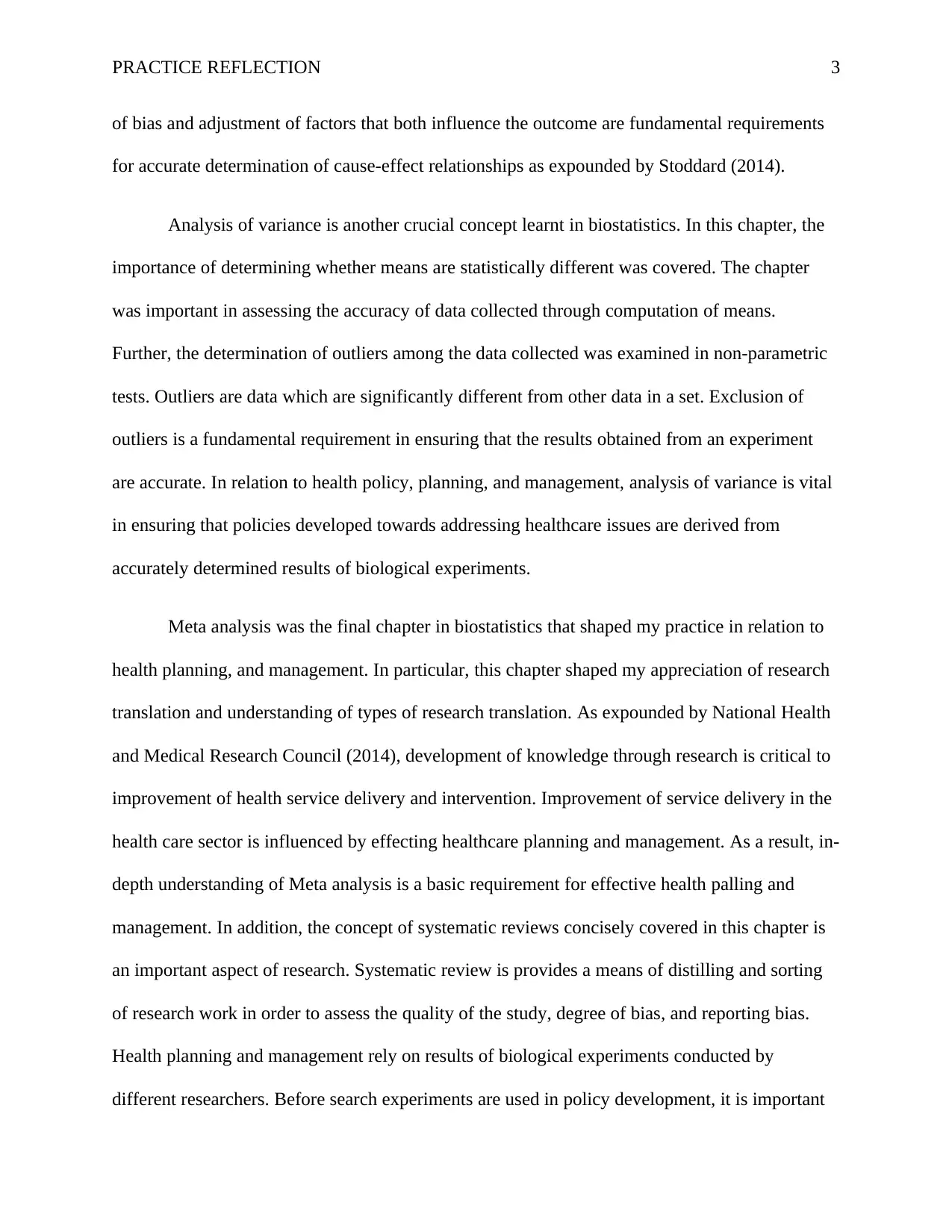
PRACTICE REFLECTION 3
of bias and adjustment of factors that both influence the outcome are fundamental requirements
for accurate determination of cause-effect relationships as expounded by Stoddard (2014).
Analysis of variance is another crucial concept learnt in biostatistics. In this chapter, the
importance of determining whether means are statistically different was covered. The chapter
was important in assessing the accuracy of data collected through computation of means.
Further, the determination of outliers among the data collected was examined in non-parametric
tests. Outliers are data which are significantly different from other data in a set. Exclusion of
outliers is a fundamental requirement in ensuring that the results obtained from an experiment
are accurate. In relation to health policy, planning, and management, analysis of variance is vital
in ensuring that policies developed towards addressing healthcare issues are derived from
accurately determined results of biological experiments.
Meta analysis was the final chapter in biostatistics that shaped my practice in relation to
health planning, and management. In particular, this chapter shaped my appreciation of research
translation and understanding of types of research translation. As expounded by National Health
and Medical Research Council (2014), development of knowledge through research is critical to
improvement of health service delivery and intervention. Improvement of service delivery in the
health care sector is influenced by effecting healthcare planning and management. As a result, in-
depth understanding of Meta analysis is a basic requirement for effective health palling and
management. In addition, the concept of systematic reviews concisely covered in this chapter is
an important aspect of research. Systematic review is provides a means of distilling and sorting
of research work in order to assess the quality of the study, degree of bias, and reporting bias.
Health planning and management rely on results of biological experiments conducted by
different researchers. Before search experiments are used in policy development, it is important
of bias and adjustment of factors that both influence the outcome are fundamental requirements
for accurate determination of cause-effect relationships as expounded by Stoddard (2014).
Analysis of variance is another crucial concept learnt in biostatistics. In this chapter, the
importance of determining whether means are statistically different was covered. The chapter
was important in assessing the accuracy of data collected through computation of means.
Further, the determination of outliers among the data collected was examined in non-parametric
tests. Outliers are data which are significantly different from other data in a set. Exclusion of
outliers is a fundamental requirement in ensuring that the results obtained from an experiment
are accurate. In relation to health policy, planning, and management, analysis of variance is vital
in ensuring that policies developed towards addressing healthcare issues are derived from
accurately determined results of biological experiments.
Meta analysis was the final chapter in biostatistics that shaped my practice in relation to
health planning, and management. In particular, this chapter shaped my appreciation of research
translation and understanding of types of research translation. As expounded by National Health
and Medical Research Council (2014), development of knowledge through research is critical to
improvement of health service delivery and intervention. Improvement of service delivery in the
health care sector is influenced by effecting healthcare planning and management. As a result, in-
depth understanding of Meta analysis is a basic requirement for effective health palling and
management. In addition, the concept of systematic reviews concisely covered in this chapter is
an important aspect of research. Systematic review is provides a means of distilling and sorting
of research work in order to assess the quality of the study, degree of bias, and reporting bias.
Health planning and management rely on results of biological experiments conducted by
different researchers. Before search experiments are used in policy development, it is important
⊘ This is a preview!⊘
Do you want full access?
Subscribe today to unlock all pages.

Trusted by 1+ million students worldwide
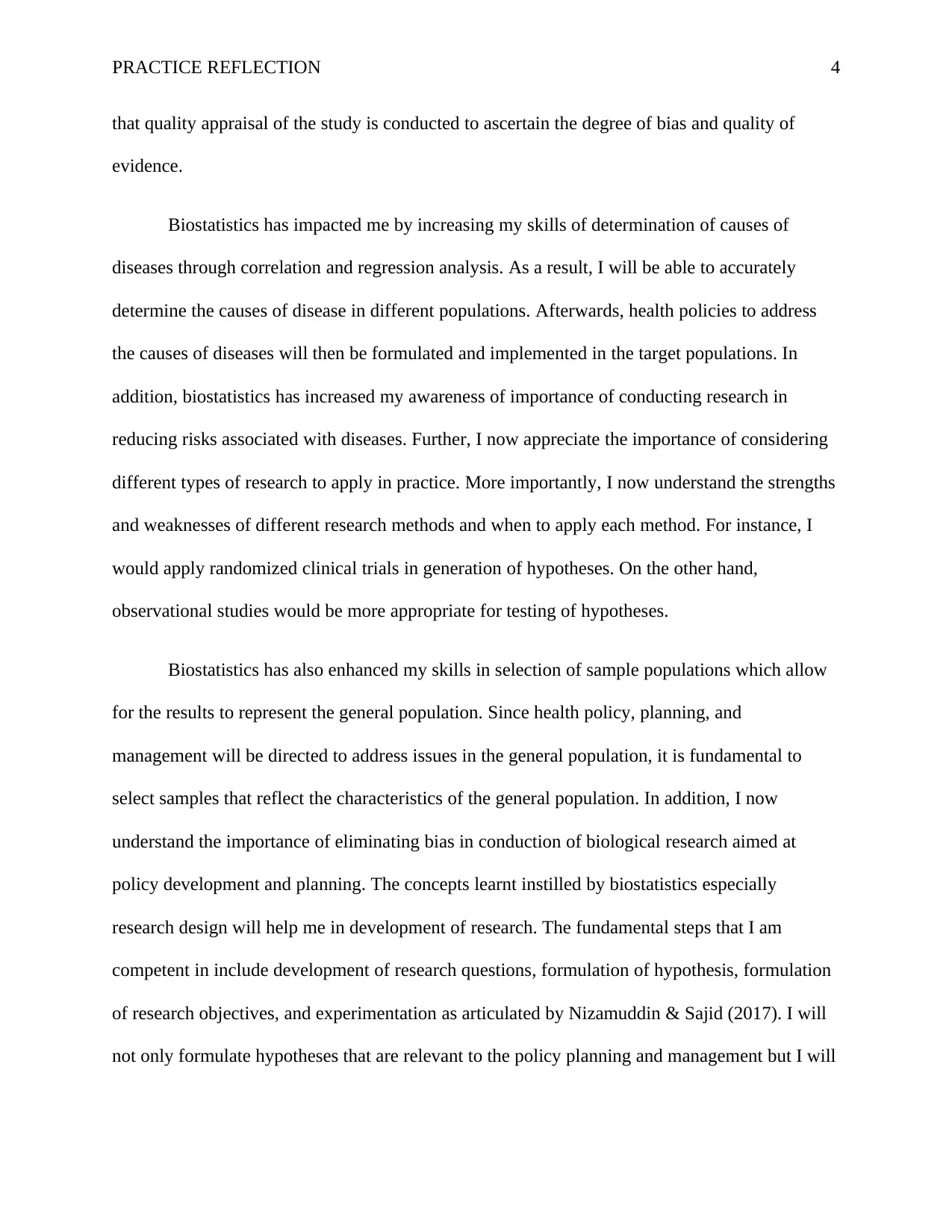
PRACTICE REFLECTION 4
that quality appraisal of the study is conducted to ascertain the degree of bias and quality of
evidence.
Biostatistics has impacted me by increasing my skills of determination of causes of
diseases through correlation and regression analysis. As a result, I will be able to accurately
determine the causes of disease in different populations. Afterwards, health policies to address
the causes of diseases will then be formulated and implemented in the target populations. In
addition, biostatistics has increased my awareness of importance of conducting research in
reducing risks associated with diseases. Further, I now appreciate the importance of considering
different types of research to apply in practice. More importantly, I now understand the strengths
and weaknesses of different research methods and when to apply each method. For instance, I
would apply randomized clinical trials in generation of hypotheses. On the other hand,
observational studies would be more appropriate for testing of hypotheses.
Biostatistics has also enhanced my skills in selection of sample populations which allow
for the results to represent the general population. Since health policy, planning, and
management will be directed to address issues in the general population, it is fundamental to
select samples that reflect the characteristics of the general population. In addition, I now
understand the importance of eliminating bias in conduction of biological research aimed at
policy development and planning. The concepts learnt instilled by biostatistics especially
research design will help me in development of research. The fundamental steps that I am
competent in include development of research questions, formulation of hypothesis, formulation
of research objectives, and experimentation as articulated by Nizamuddin & Sajid (2017). I will
not only formulate hypotheses that are relevant to the policy planning and management but I will
that quality appraisal of the study is conducted to ascertain the degree of bias and quality of
evidence.
Biostatistics has impacted me by increasing my skills of determination of causes of
diseases through correlation and regression analysis. As a result, I will be able to accurately
determine the causes of disease in different populations. Afterwards, health policies to address
the causes of diseases will then be formulated and implemented in the target populations. In
addition, biostatistics has increased my awareness of importance of conducting research in
reducing risks associated with diseases. Further, I now appreciate the importance of considering
different types of research to apply in practice. More importantly, I now understand the strengths
and weaknesses of different research methods and when to apply each method. For instance, I
would apply randomized clinical trials in generation of hypotheses. On the other hand,
observational studies would be more appropriate for testing of hypotheses.
Biostatistics has also enhanced my skills in selection of sample populations which allow
for the results to represent the general population. Since health policy, planning, and
management will be directed to address issues in the general population, it is fundamental to
select samples that reflect the characteristics of the general population. In addition, I now
understand the importance of eliminating bias in conduction of biological research aimed at
policy development and planning. The concepts learnt instilled by biostatistics especially
research design will help me in development of research. The fundamental steps that I am
competent in include development of research questions, formulation of hypothesis, formulation
of research objectives, and experimentation as articulated by Nizamuddin & Sajid (2017). I will
not only formulate hypotheses that are relevant to the policy planning and management but I will
Paraphrase This Document
Need a fresh take? Get an instant paraphrase of this document with our AI Paraphraser
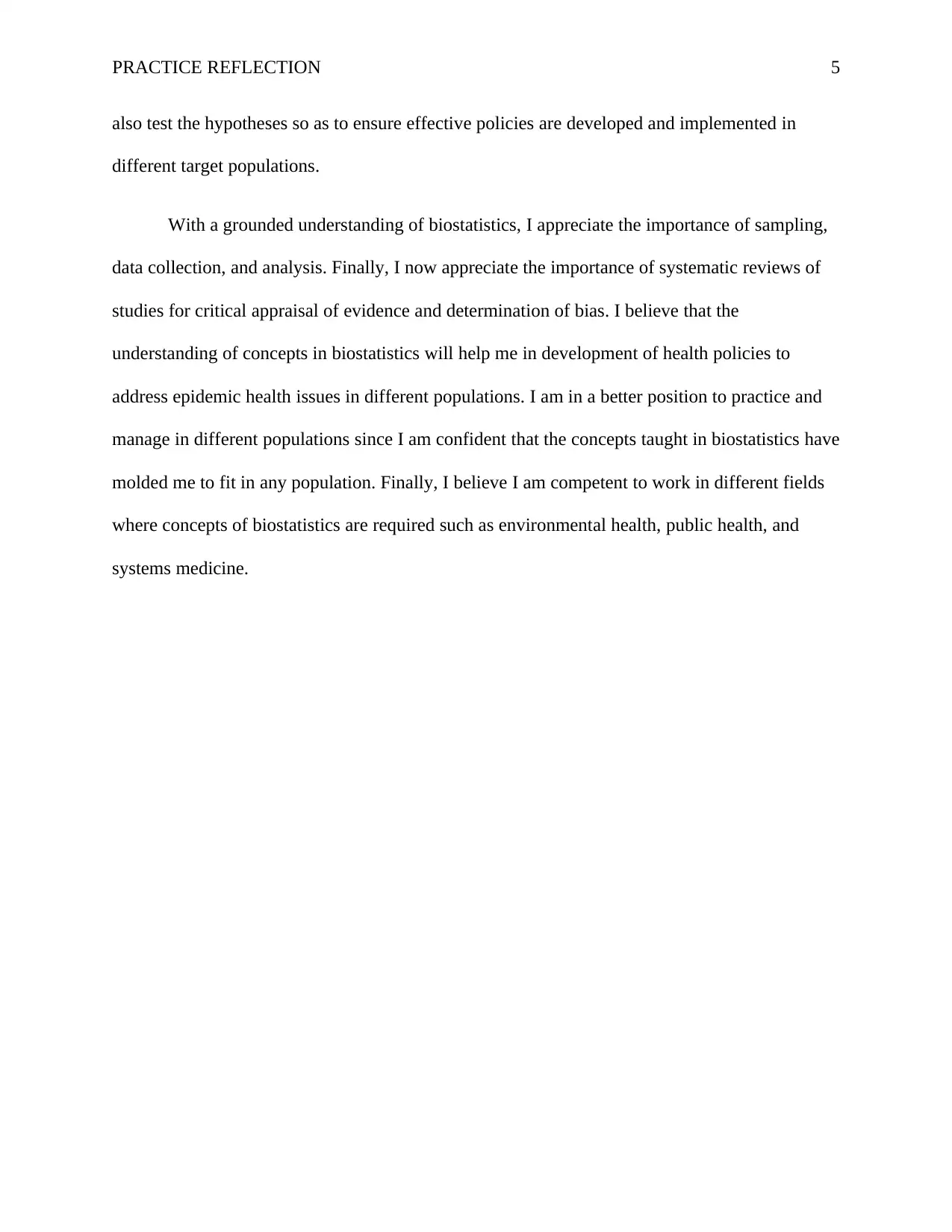
PRACTICE REFLECTION 5
also test the hypotheses so as to ensure effective policies are developed and implemented in
different target populations.
With a grounded understanding of biostatistics, I appreciate the importance of sampling,
data collection, and analysis. Finally, I now appreciate the importance of systematic reviews of
studies for critical appraisal of evidence and determination of bias. I believe that the
understanding of concepts in biostatistics will help me in development of health policies to
address epidemic health issues in different populations. I am in a better position to practice and
manage in different populations since I am confident that the concepts taught in biostatistics have
molded me to fit in any population. Finally, I believe I am competent to work in different fields
where concepts of biostatistics are required such as environmental health, public health, and
systems medicine.
also test the hypotheses so as to ensure effective policies are developed and implemented in
different target populations.
With a grounded understanding of biostatistics, I appreciate the importance of sampling,
data collection, and analysis. Finally, I now appreciate the importance of systematic reviews of
studies for critical appraisal of evidence and determination of bias. I believe that the
understanding of concepts in biostatistics will help me in development of health policies to
address epidemic health issues in different populations. I am in a better position to practice and
manage in different populations since I am confident that the concepts taught in biostatistics have
molded me to fit in any population. Finally, I believe I am competent to work in different fields
where concepts of biostatistics are required such as environmental health, public health, and
systems medicine.
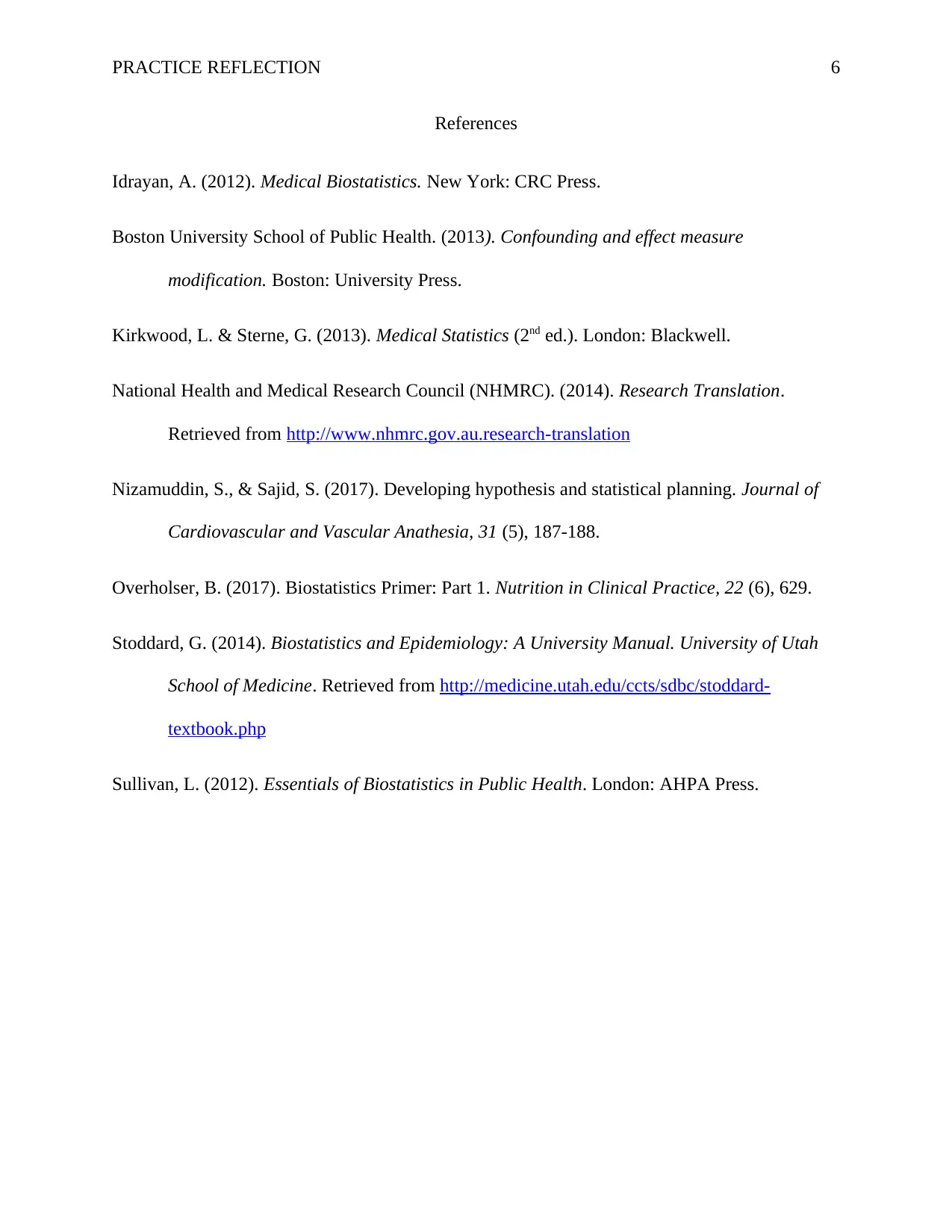
PRACTICE REFLECTION 6
References
Idrayan, A. (2012). Medical Biostatistics. New York: CRC Press.
Boston University School of Public Health. (2013). Confounding and effect measure
modification. Boston: University Press.
Kirkwood, L. & Sterne, G. (2013). Medical Statistics (2nd ed.). London: Blackwell.
National Health and Medical Research Council (NHMRC). (2014). Research Translation.
Retrieved from http://www.nhmrc.gov.au.research-translation
Nizamuddin, S., & Sajid, S. (2017). Developing hypothesis and statistical planning. Journal of
Cardiovascular and Vascular Anathesia, 31 (5), 187-188.
Overholser, B. (2017). Biostatistics Primer: Part 1. Nutrition in Clinical Practice, 22 (6), 629.
Stoddard, G. (2014). Biostatistics and Epidemiology: A University Manual. University of Utah
School of Medicine. Retrieved from http://medicine.utah.edu/ccts/sdbc/stoddard-
textbook.php
Sullivan, L. (2012). Essentials of Biostatistics in Public Health. London: AHPA Press.
References
Idrayan, A. (2012). Medical Biostatistics. New York: CRC Press.
Boston University School of Public Health. (2013). Confounding and effect measure
modification. Boston: University Press.
Kirkwood, L. & Sterne, G. (2013). Medical Statistics (2nd ed.). London: Blackwell.
National Health and Medical Research Council (NHMRC). (2014). Research Translation.
Retrieved from http://www.nhmrc.gov.au.research-translation
Nizamuddin, S., & Sajid, S. (2017). Developing hypothesis and statistical planning. Journal of
Cardiovascular and Vascular Anathesia, 31 (5), 187-188.
Overholser, B. (2017). Biostatistics Primer: Part 1. Nutrition in Clinical Practice, 22 (6), 629.
Stoddard, G. (2014). Biostatistics and Epidemiology: A University Manual. University of Utah
School of Medicine. Retrieved from http://medicine.utah.edu/ccts/sdbc/stoddard-
textbook.php
Sullivan, L. (2012). Essentials of Biostatistics in Public Health. London: AHPA Press.
⊘ This is a preview!⊘
Do you want full access?
Subscribe today to unlock all pages.

Trusted by 1+ million students worldwide
1 out of 6
Related Documents
Your All-in-One AI-Powered Toolkit for Academic Success.
+13062052269
info@desklib.com
Available 24*7 on WhatsApp / Email
![[object Object]](/_next/static/media/star-bottom.7253800d.svg)
Unlock your academic potential
Copyright © 2020–2025 A2Z Services. All Rights Reserved. Developed and managed by ZUCOL.





